13 October
The Baroque in Villafranca
Thinking and living in the centuries of the Baroque: the arts
Ms. Pilar Andueza Unanua
Chair of Navarrese Heritage and Art
Given that Villafranca stands as one of the most relevant urban and monumental ensembles of the Navarrese Baroque, the lecture was aimed at providing an overview of this artistic and cultural movement. The exhibition its most significant characteristics and manifestations served to contextualize what happened in the Navarrese town during a good part of the Modern Age.
Born in Italy and developed during the 17th century and a good part of the following century in Europe and Latin America, the Baroque is presented as an ideological and cultural system through which the European absolute monarchies and the Church tried to maintain the principles on which they were based, instrumentalizing art and images for propaganda purposes. The France of Louis XIV and the Catholic Counter-Reformation are the greatest exponents of this. This operation reached its maximum expression in the so-called Baroque festival, which acted, in the words of Blasco Esquivias, as a social balm in that society full of inequalities and imbalances.
In contrast to the triumph of reason during the Renaissance, the Baroque was an artistic movement aimed at captivating the senses and producing a sensory impact on the spectator, both in the civil and religious spheres. In this sense, the Catholic Church used all the oral -sermons- and plastic resources at its disposal, to which it added music, with three purposes: docere, delectare et movere, following to a great extent the principles of Aristotelian rhetoric.
Baroque art radiated in two main directions: on the one hand, there was a taste and interest in reality, in the immediate and the everyday. But on the other hand, there is also an inclination towards appearance, the monumental and the surprising. Examples of the former can be found in Dutch painting, with its portraits, individual and collective, its landscapes, its still lifes or its genre scenes, aimed at its powerful bourgeoisie. But it is also visible in Velázquez's painting. Given the vividness of the face in the portrait of Innocent X, it is not surprising that the supreme pontiff exclaimed "vero troppo" when he saw it, just as it is not surprising that Sandrart said when he saw the portrait of Juan de Pareja in the exhibition of the Pantheon in Rome: "everything else was painting. Only that one was true". This same tendency is visible among sculptors, among whom the great Bernini gave life to his portraits thanks to his technical virtuosity and psychological depth, as we see in the portraits of Cardinal Borghese or Constanza Bonarelli. On the other hand, the dazzling has as its background a manifestation of power and a propagandistic purpose. The Hall of Mirrors at Versailles, the extraordinary gardens, or the vaults painted by Gaulli and Pozzo in the churches of the Gesù and San Ignacio in Rome are magnificent examples of all this.
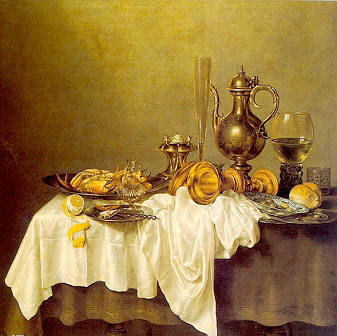
The Baroque reflected reality and the everyday as seen in Dutch still lifes.
Willem Claesz Heda
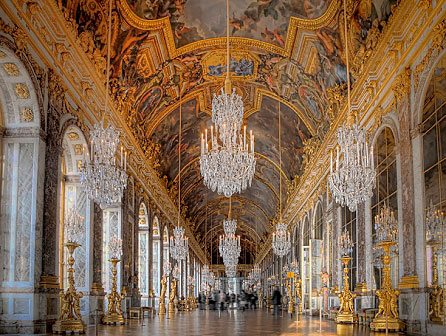
An extraordinary example of the taste for appearance, the monumental and the surprising can be found in the Hall of Mirrors at Versailles.
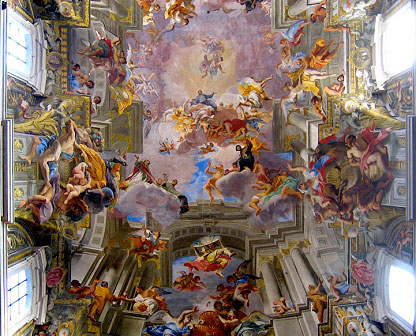
The Catholic Church used images for three purposes: docere, delectare and movere.
Andrea Pozzo: Vault of the church of St. Ignatius. Rome
Among the most significant characteristics of the Baroque we must highlight its pictorial character, not only visible in the painting inherited from the Venetian school, but also in architecture and sculpture where the mixture of materials, the taste for polychromy and light are chosen. The vibrant colors of Rubens' paintings or the play of colored marble in St. Peter's Basilica serve as sample, as does the polychromy of the rich Spanish religious imagery, or some furniture made with gold leaf, tortoiseshell or hard stones.
The Baroque also showed an extraordinary interest in light, sometimes very contrasted. It is very visible in painting, especially in tenebrist painting, but also in its changing effect on an architectural interior such as the transparent interior of the cathedral of León.
Spatial concern was a constant. From it derived the taste for movement, for open, diagonal and asymmetrical forms, visible in all the arts. Thus San Carlino, by Borromini, is an example in this sense, as are the sculptures of Bernini or again the paintings of Rubens. Closely linked to this is the interest in illusionism and theatricality, as we see in the Cornaro Chapel, the Trevi Fountain or the place of Spain in Rome, or in the imperial staircases that filled the European palaces.
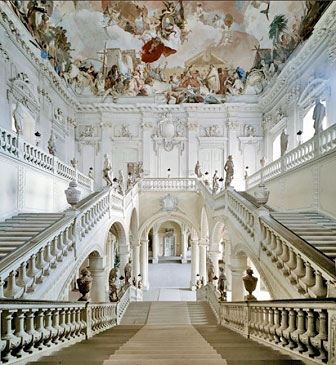
The taste for scenery and theatricality is evident in the grand imperial staircases. Wuzburg Palace
The fusion of the arts was a maxim of the Baroque, where all the arts, including the decorative ones, came together. Chapels such as Santa Ana de Tudela or the Rosary Chapel in Puebla de los Angeles (Mexico) or many Central European churches clearly demonstrate this.
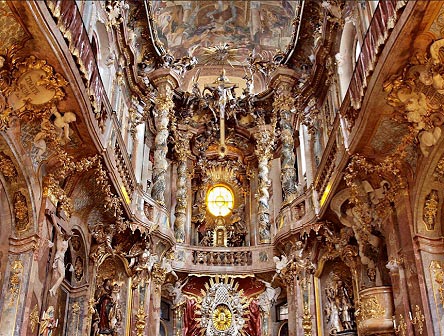
The interest in color, light, spatial concern and movement, as well as the scenography and fusion of the arts is seen in the church of St. John of Nepomuk in Munich.
Finally, magnificence was always very present. Following the Aristotelian principle, whoever had economic means and social pre-eminence, was obliged to spend agreement with his economic and social position. This idea favored a great development not only of architecture, sculpture and painting, but also, and in a very special way, the decorative arts, from embroidery to furniture, through the art of silverware, tapestries or jewelry.
